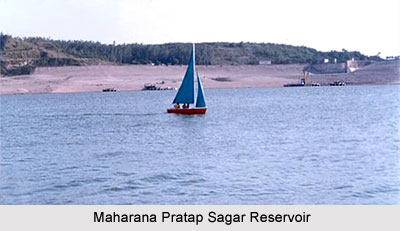 Maharana Pratap Sagar is a reservoir located in the Kangra district of Himachal Pradesh. The lake is named in memory of the great warrior Maharana Pratap. Earlier it was known as the Pong Dam Reservoir. Geographically, the lake is situated at a height of 450 meters above mean sea level between 32-degree North latitude and 76 degree East longitudes. The lake is situated at a distance of 170 kilometers from Chandigarh and 110 kilometers from Dharamshala, the district headquarters. The reservoir is also one of the 25 wetland sites declared by the Ramsar Convention.
Maharana Pratap Sagar is a reservoir located in the Kangra district of Himachal Pradesh. The lake is named in memory of the great warrior Maharana Pratap. Earlier it was known as the Pong Dam Reservoir. Geographically, the lake is situated at a height of 450 meters above mean sea level between 32-degree North latitude and 76 degree East longitudes. The lake is situated at a distance of 170 kilometers from Chandigarh and 110 kilometers from Dharamshala, the district headquarters. The reservoir is also one of the 25 wetland sites declared by the Ramsar Convention.
The main purpose of the reservoir is to supply irrigation as well as drinking water to the states of Chandigarh, Punjab, Delhi, Rajasthan and Himachal Pradesh.
The reservoir is encircled by the rugged Dhauldhar mountain ranges and by the low foothills of the Himalyas. The reservoir is well known for its flora and fauna. It being located in the extreme north-west of the country attracts a large number of migratory birds from Central Asia. Every year more than two hundred species of birds visit the reservoir and as a result in 1983, the Sagar was declared a Bird Sanctuary. Some of the common species found here are black-headed gulls, plovers, northern pintail, Black stork, Goose, terns, ducks, waterfowl and egrets. Apart from the birds around 27 species of fishes are found in the lake area. The other types of animals that are found in the lake are barking deer, leopards, sambar, wild boars and a lot more.
The vegetation of the area surrounding the reservoir is mainly of a deciduous and perennial variety. Trees like eucalyptus, shisham, jamun tree, acacia tree, mango tree, mulberry, amala, prunus and varieties assisting the livelihood of the migratory birds are generally found in the forestation.
The Pong or the Maharana Pratap Sagar Dam serves as a major ground for water sports. Throughout the year activities like swimming, water skiing, surfing, rowing and sailing are part of the lake area.
The declaration of the entire reservoir area as a Wild Life Sanctuary in the year 1986 has prevented the practice of poaching in the lake area.
Thus it can be said that the reservoir not only supplies irrigation and drinking water to the neighbouring states but is also a major tourist attraction.















